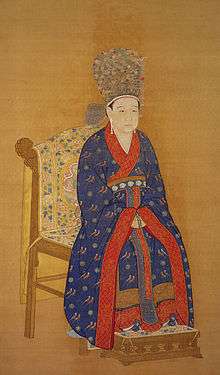Empress Yang (Song dynasty)

Empress Gongsheng (1162–1232), surnamed Yang, was a Chinese Empress consort of the Song dynasty, married to Emperor Ningzong of Song. She served as the co-regent of Emperor Lizong from 1224 until 1232.[1]
Artist
It is said that she came from Kuaiji. She was reportedly either the biological or the adopted daughter of a female musician, Zhang Shansheng (d. 1170), who was at one point employed in the palace, and became and actress in service of the Empress Dowager Wu.[2] In this position, she cam to the attention of the future Emperor Ningzong. She had the palace eunuchs find an official who was willing to be her accomplice in changing her family history, and with his cooperation, she claimed to be the sister of the official Yang Cishan, and assumed his surname Yang.[3]
Consort
In 1195, the first year of the Qingyuan era, she married with Zhao Kuang, and was named the Lady of Pinglejunfuren (平乐郡夫人). She was promoted to the title jieyu (婕妤) three years later. In the fifth year of Qingyuan (1199), Yang was promoted to wanyi (婉仪), and to guifei (贵妃) a year later. In 1200, Empress Gongshu died of an illness. Both Beauty Cao (曹美人), described as gentle and submissive, and Yang were favoured by the emperor. Han Tuozhou, an uncle of the dead Empress Han, advised against the appointment of Yang because of her ambition. The Emperor arranged a dinner for each consort to decide which one to make his empress. Yang allowed Cao to have her dinner first. This meant, that the Emperor came to Yang's dinner at night, being already somewhat drunk after having attended the dinner of consort Cao. Yang convinced the drunk emperor to sign the edict making her empress at the table.[4] The first edict was intercepted by Han Tuouzou, as she had expected. Believing he had won over her, Han Tuouzou relaxed his guard, while Yang triumphed over him by convincing the emperor to sign another edict making her empress.[5]
Empress Yang did not forgive Han Tuouzou, tried several times to turn the emperor against him, and finally sent her ally Shi Miyuan to murder him in 1207.[6] The emperor discovered the plot, but she pleaded with him not to side with her enemy less she should commit suicide, and he agreed not to interfere.[7] Her Shi Miyuan rose in rank and eventually became grand councillor. Shi Miyuan had a girl placed as a spy with the designated crown prince of the emperor, and in 1223, she reported that the crown prince was planning to depose him when he became emperor.[8] When Emperor Ningzong died in 1224, Shi Miyuan wished to have another of the Imperial princes, the future Emperor Lizong, placed on the throne instead.[9] Empress Yang initially refused to cooperate, but when Shi Miyuan threatened to have the entire Yang clan massacred, she agreed to fabricate the edict which installed Emperor Lizong on the throne.[10]
Regent
In gratitude for giving him the throne, Emperor Lizong invited her to reign as his co-regent behind a lowered screen.[11] She accepted the offer and ruled jointly with him until her death in 1232, eight years later.[12] To the opposition of many at court, she selected Empress Xie Daoqing rather than the emperors favorite consort Jia (d. 1247) as empress.
In the second year of Baoqing (1226), Empress Gongsheng became Empress dowager Shouming. In the first year of Shaoding (1228), she was additionally named Empress Dowager Shoumingcirui (寿明慈睿皇太后). In the fourth year of Shaoding (1231), she was made Empress Dowager Shoumingrenfucirui (寿明仁福慈睿皇太后). In the fifth year, she died in Ciming Palace, and was named Gongshengrenlie (恭圣仁烈) posthumously.
References
- ↑ Lily Xiao Hong Lee, Sue Wiles: Biographical Dictionary of Chinese Women, Volume II: Tang Through Ming 618 - 1644
- ↑ Lily Xiao Hong Lee, Sue Wiles: Biographical Dictionary of Chinese Women, Volume II: Tang Through Ming 618 - 1644
- ↑ Lily Xiao Hong Lee, Sue Wiles: Biographical Dictionary of Chinese Women, Volume II: Tang Through Ming 618 - 1644
- ↑ Lily Xiao Hong Lee, Sue Wiles: Biographical Dictionary of Chinese Women, Volume II: Tang Through Ming 618 - 1644
- ↑ Lily Xiao Hong Lee, Sue Wiles: Biographical Dictionary of Chinese Women, Volume II: Tang Through Ming 618 - 1644
- ↑ Lily Xiao Hong Lee, Sue Wiles: Biographical Dictionary of Chinese Women, Volume II: Tang Through Ming 618 - 1644
- ↑ Lily Xiao Hong Lee, Sue Wiles: Biographical Dictionary of Chinese Women, Volume II: Tang Through Ming 618 - 1644
- ↑ Lily Xiao Hong Lee, Sue Wiles: Biographical Dictionary of Chinese Women, Volume II: Tang Through Ming 618 - 1644
- ↑ Lily Xiao Hong Lee, Sue Wiles: Biographical Dictionary of Chinese Women, Volume II: Tang Through Ming 618 - 1644
- ↑ Lily Xiao Hong Lee, Sue Wiles: Biographical Dictionary of Chinese Women, Volume II: Tang Through Ming 618 - 1644
- ↑ Lily Xiao Hong Lee, Sue Wiles: Biographical Dictionary of Chinese Women, Volume II: Tang Through Ming 618 - 1644
- ↑ Lily Xiao Hong Lee, Sue Wiles: Biographical Dictionary of Chinese Women, Volume II: Tang Through Ming 618 - 1644
- History of the Song Dynasty. Liezhuan. Empress Part Two
| Chinese royalty | ||
|---|---|---|
| Preceded by Empress Gongshu |
Empress of China 1200–1224 |
Succeeded by Empress Xie Daoqing |